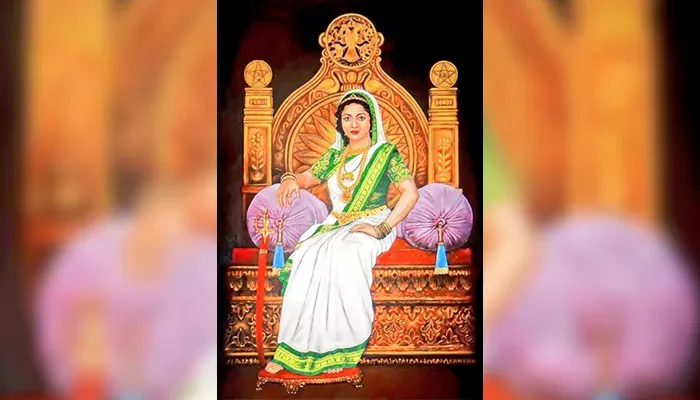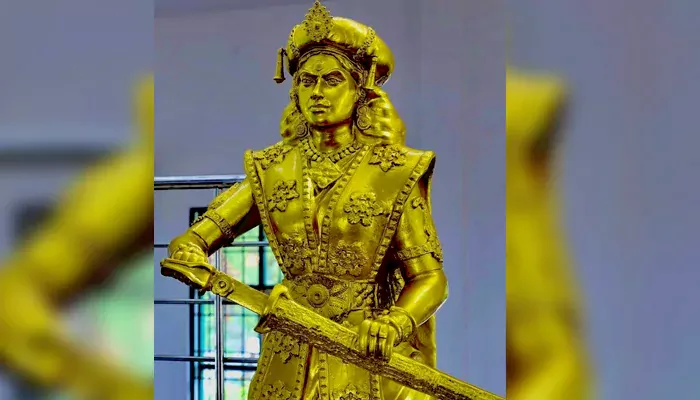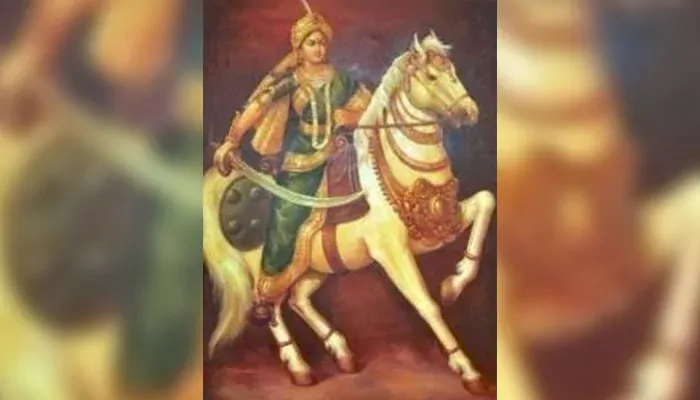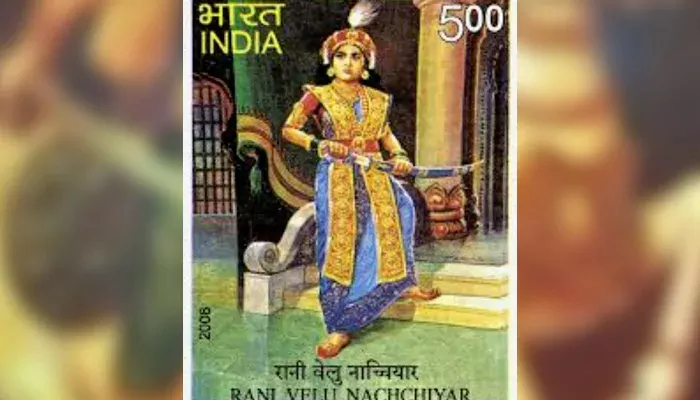
Velu Nachiyar was the first Indian queen to wage war with the East India Company in India.
We’ve all grown up hearing the valiant tale of Rani Lakshmibai, the warrior queen who stood up to the British with unmatched courage. Her story remains iconic, not only because she fought an empire, but because she did so as a woman in a deeply patriarchal world. But what if we told you she wasn’t the first? Long before the uprising of 1857, decades before Lakshmibai picked up the sword, there was another fearless queen who dared to challenge the British East India Company, and she did it when their grip on India was just tightening. Her name was Velu Nachiyar.

As India prepares to celebrate its 79th Independence Day, it’s time we remember not just the familiar faces of freedom but also those hidden in the folds of forgotten history. Without an iota of doubt, Velu Nachiyar’s story is of the kind of fire that lit the way for generations to come.
Born in 1730 in Ramanathapuram to Raja Chellamuthu Vijayaragunatha Sethupathy and Rani Sakandhimuthal, Velu Nachiyar was no ordinary royal. As the only heir, she was raised more like a prince, trained in martial arts, archery, horse riding, and in the use of traditional Tamil weapons like the valari (a boomerang-like tool) and silambam (stick combat).
However, tragedy struck in 1772 when her husband, Muthuvaduganatha Periyavudaya Thevar, king of Sivaganga, was killed in a surprise attack by the combined forces of the British and the Nawab of Arcot at Kalaiyar Koil. Many rulers may have surrendered in despair, but not Velu Nachiyar. She vowed to take back her kingdom.

Eight years later, in 1780, she launched a daring assault on the British, making history as the first Indian queen to engage in a full-fledged war against colonial powers, decades before the Revolt of 1857. As historian V. Sriram notes, “Velu Nachiyar was likely the first woman ruler to confront the British, a feat that predates even Lakshmibai.” Her victory in reclaiming Sivaganga marked one of the earliest acts of resistance against British imperialism.
No story of Velu Nachiyar is complete without Kuyili, the commander of her women’s army and a hero in her own right. Belonging to the Arunthathiyar community, Kuyili was fiercely loyal to the queen, and when the time came, she didn’t hesitate to make the ultimate sacrifice.
During the siege of Sivaganga in 1780, the British had stored ammunition in the Raja Rajeswari temple inside the fort. Disguised as devotees during Vijayadashami, Kuyili and a group of women smuggled weapons hidden in flower baskets into the fort. Knowing that crippling the enemy's firepower was key, Kuyili drenched herself in ghee, set herself ablaze, and leapt into the ammunition depot, causing a massive explosion that turned the tide of the battle.
Kuyili
— The Epic Lady 🇮🇳 (@sincerely_epic) June 21, 2025
A dalit woman commander -in -chief, in reign of Queen Velu Nachiyar.
Kuyili's bravery & brilliance allowed Velu Nachiyar to not only win the battle against the British, but also reclaim her kingdom.
It's a hard slap on face of those, who always portray SC as victims... pic.twitter.com/JEkUDkKMmB
(Credit: The Epic Lady)
Her act of self-sacrifice is regarded by many as India’s first suicide bombing. In local folklore, she is remembered as Theepanjali Amman, the goddess who embraced fire. As author R. Lenin observes, “Kuyili’s bravery was so profound that it continues to echo in Sivaganga’s folk songs.”
Velu Nachiyar wasn’t just fearless on the battlefield; she was intellectually formidable too. She was fluent in multiple languages, including French, English, and Urdu. These linguistic skills helped her gather intelligence and build crucial diplomatic ties.
Her fluency in Urdu especially impressed Hyder Ali of Mysore, one of her strongest allies. While living in exile under his protection in Dindigul, she studied British military tactics, trained her army, and prepared for war. Historian K. Jeevabharathi notes, “Her strategic mind was her greatest weapon, blending local terrain knowledge with advanced warfare tactics.”
Her time in exile was anything but passive. She built an army of 5,000, secured gunpowder supplies, and refined her plans. When she returned, she came not just as a grieving queen but as a seasoned war leader.
Velu Nachiyar understood early on that defeating the British would require more than just courage. After escaping Sivaganga in 1772 with her daughter Vellachi and key allies like Thandavarayan Pillai, she set about building a powerful coalition.
Her alliance with Hyder Ali brought her trained soldiers and resources, while local support came from the Maruthu Brothers and several regional chieftains. But perhaps her most ingenious weapon was guerrilla warfare, long before the term became mainstream in India’s freedom struggle.

Her forces used ambushes, sabotage, and espionage to great effect. Kuyili’s women disguised as temple-goers, informants slipping inside enemy camps, and surprise night attacks were part of her playbook. As The Better India notes, “Her guerrilla tactics predated their widespread use, making her a true pioneer of asymmetric warfare.”
The loss of her husband and her kingdom could have ended Velu Nachiyar’s story, but she turned grief into grit. For nearly a decade, she lived in hiding, first with the Kallar leaders in the forests, and then in Dindigul, where she rebuilt from scratch.
A 1772 letter to Hyder Ali, penned by her loyal minister Thandavarayan Pillai, reads like a cry for justice: “Arcot Nawab’s forces occupy Sivaganga, destroying. I escaped and continued the rebellion.”
By 1780, her strategy was complete. Kuyili’s fiery assault on the British ammunition depot crippled their forces. Velu Nachiyar launched her offensive. British commander Captain Benjour, overwhelmed and outmaneuvered, pleaded for mercy. She spared his life (choosing dignity over vengeance) and reclaimed her throne.
She ruled Sivaganga for the next 16 years, until 1796, installing her daughter Vellachi and the Maruthu Brothers in key leadership roles.
Velu Nachiyar’s most revolutionary move may well have been the formation of an all-women army, something almost unthinkable in 18th-century India. Named Udaiyaal after her adopted daughter, who died in a suicide attack, the regiment was led by Kuyili and trained in combat, espionage, and guerrilla tactics.
At a time when women were largely confined to domestic roles, Velu Nachiyar shattered conventions. Feminism in India aptly writes, “Her all-women army broke gender norms wide open, proving that women could be warriors, leaders, and agents of change.” The Udaiyaal played a crucial role in the 1780 assault, risking their lives and rewriting the narrative of who could be a freedom fighter.
Her leadership wasn’t just about resistance. It was about reimagining power structures and empowering the marginalized.
Despite her heroic achievements, Velu Nachiyar’s story remained in the shadows for centuries. One reason is geography; mainstream Indian history has long been dominated by figures from the north and central parts of the country. Southern icons often receive less national attention.
Another factor is the limited documentation from her time. Much of her story was preserved through oral traditions and folk narratives, which colonial historians often dismissed. And there was the gender bias; an independent woman ruler backed by a Dalit commander was perhaps too radical for the era’s chroniclers.
As researcher S.M. Kamal notes, “Sivaganga’s oral histories preserved her legacy, but national narratives favored better-documented figures like Lakshmibai.” Kuyili’s caste identity also meant her sacrifice was often erased or downplayed in upper-caste retellings.

Thankfully, the tide is turning. In recent years, Tamil Nadu’s cultural groups, historians, and feminists have worked to bring her legacy to light through plays, books, dance performances, and even rap songs like Professor A.L.I.’s Our Queen.
In 2008, the Government of India finally honored Velu Nachiyar with a commemorative postage stamp. In 2014, Tamil Nadu's then-Chief Minister J. Jayalalithaa unveiled a six-foot bronze statue in Sivaganga and officially recognized January 3rd as her birth anniversary. A memorial to Kuyili also stands in Sivaganga today, making it a modest yet powerful tribute to a warrior whose sacrifice changed history. While the recognition came late, it signals a growing effort to honor unsung heroes who defied caste, gender, and colonial power structures.
In 2022, Prime Minister Narendra Modi tweeted, “Her indomitable courage shall keep motivating generations.”